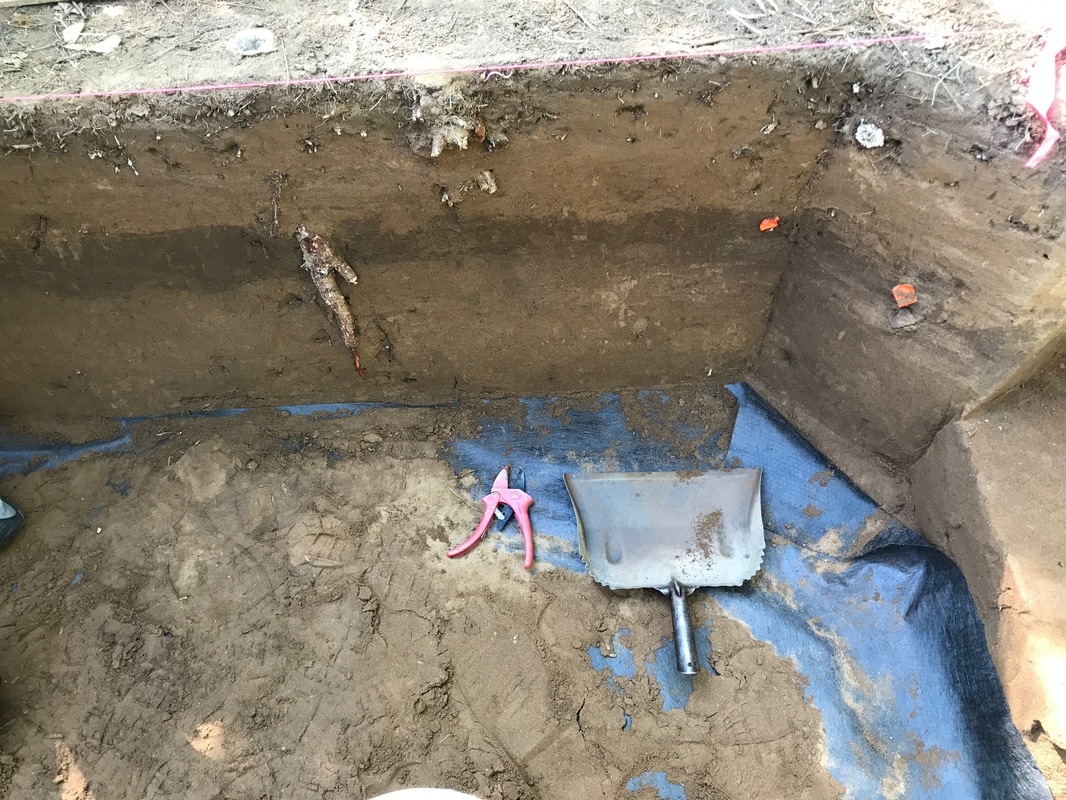|
This past Friday was our last doing any actual plotting or excavating. Units 4 and 6 finished piece-plotting their last artifacts and began to work on profiling their walls. I had done this the previous week on the Unit 1/2 profile after we removed the plywood protecting it. Profiling is done to display the stratigraphy of the soil and any features that may be within each level as well as their relationship to the site. After being recruited to help with Unit 4’s east wall, Sam and I set about making a level line to measure the depth of each zone in the wall. After we cleaned up the wall with trowels and dustpans to prepare it for final photographing, we drew our profile. Landscape fabric had been placed down already to protect the floor of the units from any further trampling. The fabric will aid in the reopening process when they come back in the future to carry on where we left off. Soon after it was time for lunch and we discussed the next step of backfilling. Honestly, I thought would be more complex a process but it pretty much means you just put some dirt along the edges to keep the fabric down and then go nuts and get all that dirt you took out over the past few weeks back into the pit. We couldn’t fill it up too far as to disturb the ongoing plotting process in Unit 5 so we had a good 20 cm in and had to be reassigned to other jobs. Some of us went to help Jim and DuVal cut back the wall of the collapsed Unit 9 to aid in shoring up that unit. Others helped Unit 5 profile. Once we were done with Unit 9, plywood was laid on the floor and we spread some landscape fabric down from above the profile wall. We set about filling in the top of Units 1/2 that now had been resealed by DuVal with some extensive carpentry. Unfortunately, part of this wall collapsed as we were putting dirt in it from above and so we had to go about dumping it a bit more carefully down into the unit. But by the end of the day most of Units 1/2 was filled in and Unit 9 was covered to be filled next time on our last day. Upstairs, Units 4, 5 and 6 were filled to about halfway up from where they were. Next week it won’t take very long at all to fill the rest back in. Hopefully enough people will be able to help Dr. White with his ongoing excavation but for now its pretty much all finished for the semester.
0 Comments
It’s been a busy week at the Broad River site! That’s to be expected, given that it’s the second to last day of field school. Last week we finished digging to depth in Units 4 and 6, so all we had to do now was draw wall profiles. Because these units will be hopefully reopened in a few months, we took care to preserve the floor. I was tasked with unrolling and cutting landscaping fabric, which was stretched across the floor and covered with about an inch of dirt. This allowed for easy travel across the floor without disturbing it. With the floor secured, we got to work shaving and mapping the profile walls. We completely flattened any marks left on the vertical surfaces surrounding our hole, so we could get the most accurate possible picture of the site’s stratigraphy. Dr. White then went through and marked the various stratigraphic zones with horizontal lines that we then drew on a sheet of graph paper. Kate and I finished drawing our wall and were able to take lunch early. After lunch, we set out to secure the walls in the same way we did the floor. We rolled more landscaping fabric around the edges and set boards of plywood against the walls so that they wouldn’t collapse while the site is deserted. The landscaping fabric allows for water to flow freely through the ground without actually moving any sediment. So the sand will stay in place, but won't become swampy and flooded. Jake and I were sent downstairs to help DuVal and Jim Legg secure the profile wall before backfilling it as well. We helped straighten the wall left by the Unit 9 collapse so DuVal could set plywood walls along the profile, behind which dirt would be poured to keep everything intact. After the walls were in place protecting Units 1 and 2, Jake and I started pouring dirt into the crevice between the plywood and the dirt wall. Unfortunately, the fill dirt began pushing out the bottom of the plywood structure and backfilling was halted until the wall could be reinforced with additional lumber (and backdirt piled along the exterior base).
Jake and I returned to the upstairs unit to assist with backfilling there. The most heartbreaking part of the entire field school was piling dirt into a hole I'd spent all semester excavating. We began an assembly line with people scooping buckets of dirt and others lugging said buckets to the hole. We placed dirt around the edges first to keep the plywood secure throughout the backfilling process. We didn't quite finish filling the hole this week, but today was probably the most physically taxing of any day so far this semester. I would die happy if I never had to see another bucket of dirt. But alas, more buckets shall there be next week, on the last day of Spring '17 field school. |
Student Blog (2017)Blog posts written by the students of the 2017 Broad River Archaeological Field School Archives
April 2017
Categories
All
|






 RSS Feed
RSS Feed
